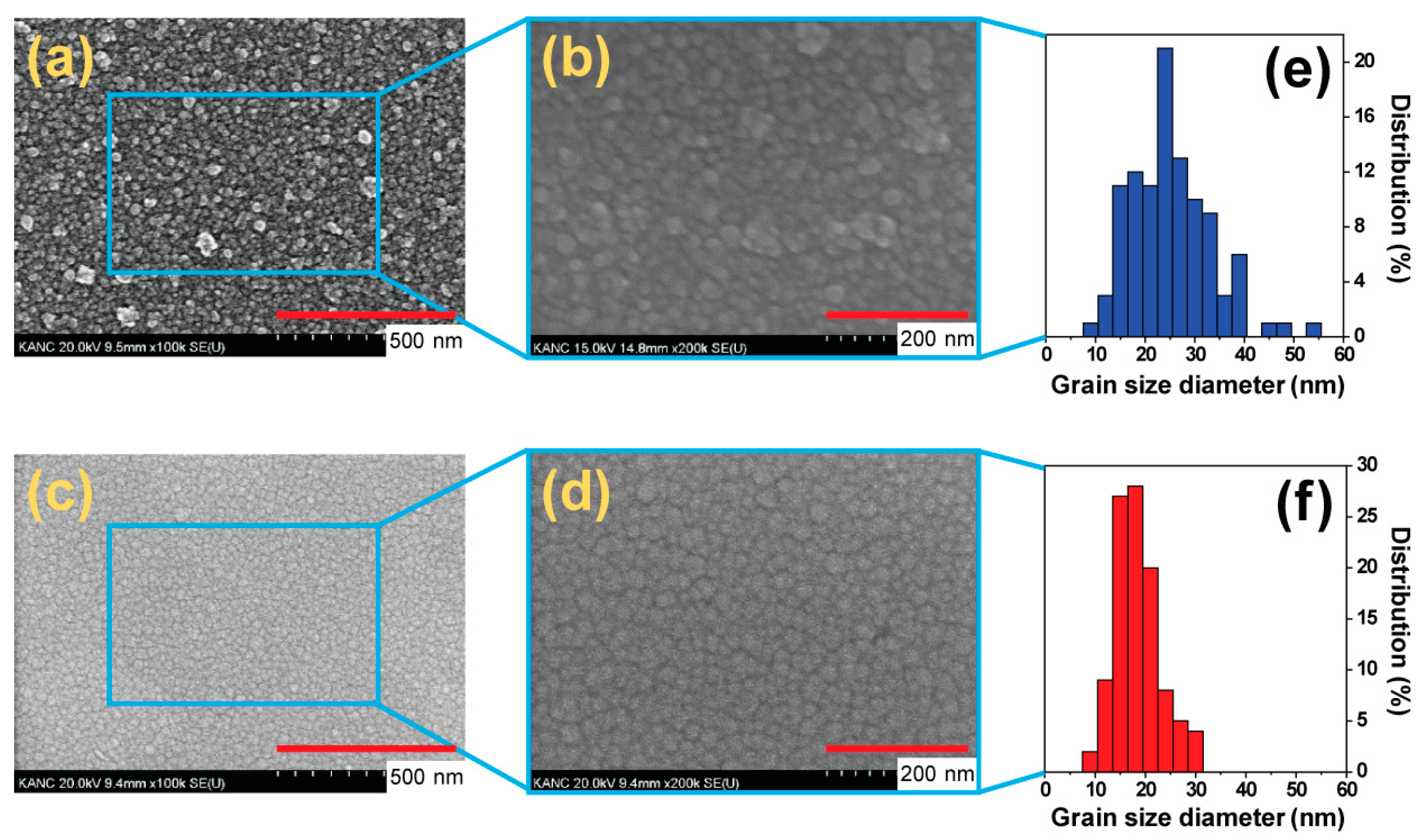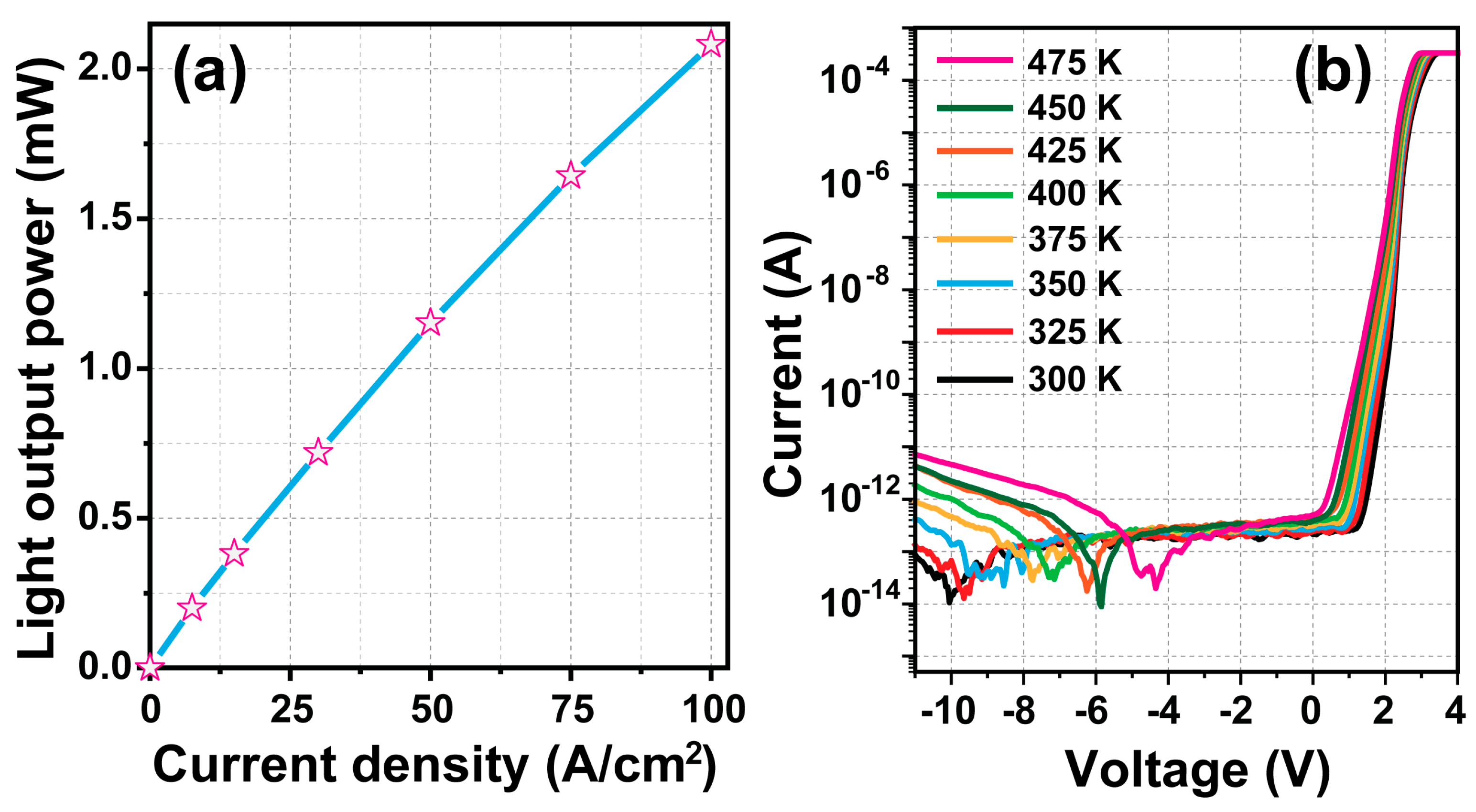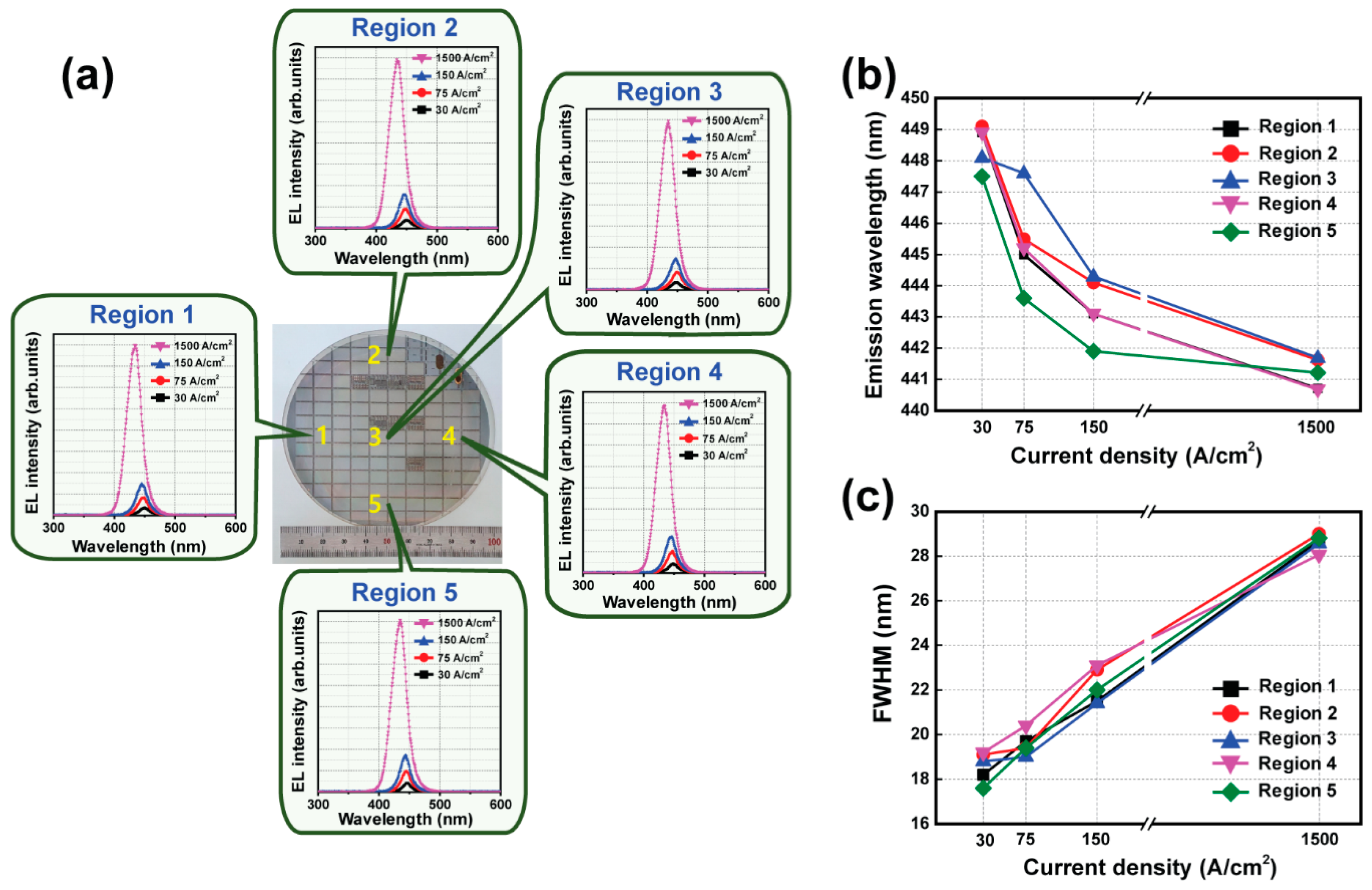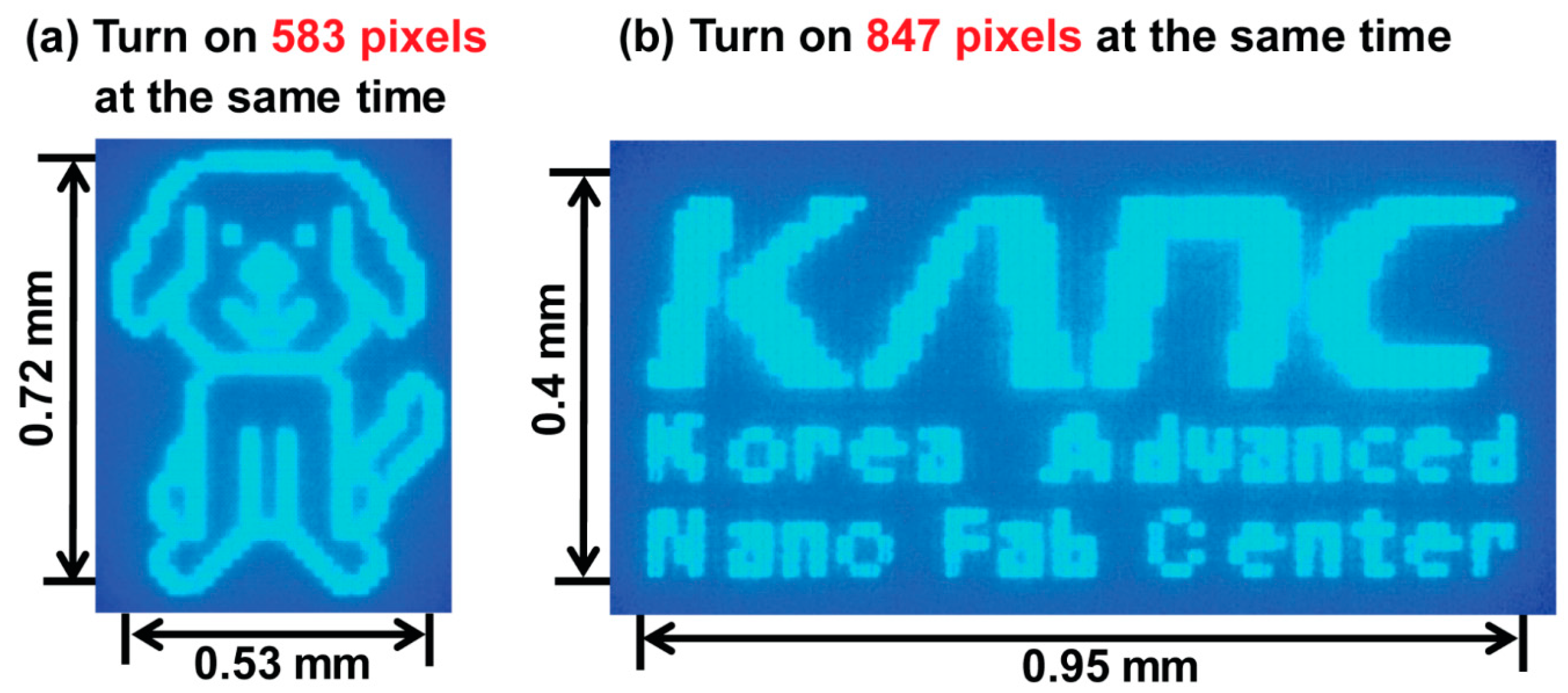Wafer-Scale Characterization of 1692-Pixel-Per-Inch Blue Micro-LED Arrays with an Optimized ITO Layer
Abstract
:1. Introduction
2. Experimental Section
3. Results and Discussion
4. Conclusions
Author Contributions
Funding
Data Availability Statement
Conflicts of Interest
References
- Huang, Y.; Hsiang, E.-L.; Deng, M.-Y.; Wu, S.-T. Mini-LED, Micro-LED and OLED Displays: Present status and future perspectives. Light Sci. Appl. 2020, 9, 105. [Google Scholar] [CrossRef] [PubMed]
- Chen, Z.; Yan, S.; Danesh, C. MicroLED technologies and applications: Characteristics, fabrication, progress, and challenges. J. Phys. D Appl. Phys. 2021, 54, 123001. [Google Scholar] [CrossRef]
- Wu, T.; Sher, C.W.; Lin, Y.; Lee, C.F.; Liang, S.; Lu, Y.; Chen, S.W.H.; Guo, W.; Kuo, H.C.; Chen, Z. Mini-LED and micro-LED: Promising candidates for the next generation display technology. Appl. Sci. 2018, 8, 1577. [Google Scholar] [CrossRef]
- Lin, J.Y.; Jiang, H.X. Development of microLED. Appl. Phys. Lett. 2020, 116, 100502. [Google Scholar] [CrossRef]
- Qi, L.; Zhang, X.; Chong, W.C.; Li, P.; Lau, K.M. 848 ppi high-brightness active-matrix micro-LED micro-display using GaN-on-Si epi-wafers towards mass production. Opt. Express 2021, 29, 10580–10591. [Google Scholar] [CrossRef] [PubMed]
- Lu, S.; Li, J.; Huang, K.; Liu, G.; Zhou, Y.; Cai, D.; Zhang, R.; Kang, J. Designs of InGaN micro-LED structure for improving quantum efficiency at low current density. Nanoscale Res. Lett. 2021, 16, 99. [Google Scholar] [CrossRef] [PubMed]
- Xiong, J.; Hsiang, E.-L.; He, Z.; Zhan, T.; Wu, S.-T. Augmented reality and virtual reality displays: Emerging technologies and future perspectives. Light Sci. Appl. 2021, 10, 216. [Google Scholar] [CrossRef] [PubMed]
- Bae, J.; Shin, Y.; Yoo, H.; Choi, Y.; Lim, J.; Jeon, D.; Kim, I.; Han, M.; Lee, S. Quantum dot-integrated GaN light-emitting diodes with resolution beyond the retinal limit. Nat. Commun. 2022, 13, 1862. [Google Scholar] [CrossRef]
- Jin, S.X.; Li, J.; Li, J.Z.; Lin, J.Y.; Jiang, H.X. GaN microdisk light emitting diodes. Appl. Phys. Lett. 2000, 76, 631–633. [Google Scholar] [CrossRef]
- Day, J.; Li, J.; Lie, D.Y.C.; Bradford, C.; Lin, J.Y.; Jiang, H.X. III-Nitride full-scale high-resolution microdisplays. Appl. Phys. Lett. 2011, 99, 031116. [Google Scholar] [CrossRef]
- Liu, Y.; Feng, F.; Zhang, K.; Jiang, F.; Chan, K.-W.; Kwok, H.S.; Liu, Z. Analysis of size dependence and the behavior under ultrahigh current density injection condition of GaN-based Micro-LEDs with pixel size down to 3 μm. J. Phys. D Appl. Phys. 2022, 55, 315107. [Google Scholar] [CrossRef]
- Chen, J.; Brewer, W.D. Ohmic contacts on P-GaN. Adv. Electron. Mater. 2015, 1, 1500113. [Google Scholar] [CrossRef]
- Zahir, N.H.; Talik, N.A.; Harun, H.N.; Kamarundzaman, A.; Tunmee, S.; Nakajima, H.; Chanlek, N.; Shuhaimi, A.; Abd Majid, W.H. Improved performance of InGaN/GaN LED by optimizing the properties of the bulk and interface of ITO on p-GaN. Appl. Surf. Sci. 2021, 540, 148406. [Google Scholar] [CrossRef]
- Horng, R.-H.; Wuu, D.-S.; Lien, Y.C.; Lan, W.-H. Low-resistance and high-transparency Ni/indium tin oxide ohmic contacts to p-type GaN. Appl. Phys. Lett. 2001, 79, 2925–2927. [Google Scholar] [CrossRef]
- Sheremet, V.; Genç, M.; Elçi, M.; Sheremet, N.; Aydınlı, A.; Altuntaş, I.; Ding, K.; Avrutin, V.; Özgür, Ü.; Morkoç, H. The role of ITO resistivity on current spreading and leakage in InGaN/GaN light emitting diodes. Superlattices Microstruct. 2017, 111, 1177–1194. [Google Scholar] [CrossRef]
- Zhanghu, M.; Hyun, B.-R.; Jiang, F.; Liu, Z. Ultra-bright green InGaN micro-LEDs with brightness over 10M nits. Opt. Express 2022, 30, 10119–10125. [Google Scholar] [CrossRef] [PubMed]
- Leonard, J.T.; Cohen, D.A.; Yonkee, B.P.; Farrell, R.M.; Denbaars, S.P.; Speck, J.S.; Nakamura, S. Smooth E-beam-deposited tin-doped indium oxide for III-nitride vertical-cavity surface-emitting laser intracavity contacts. J. Appl. Phys. 2015, 118, 145304. [Google Scholar] [CrossRef]
- Gandrothula, S.; Kamikawa, T.; Shapturenka, P.; Anderson, R.; Wong, M.; Zhang, H.; Speck, J.S.; Nakamura, S.; Denbaars, S.P. Optical and electrical characterizations of micro-LEDs grown on lower defect density epitaxial layers. Appl. Phys. Lett. 2021, 119, 142103. [Google Scholar] [CrossRef]
- Fallah, H.R.; Ghasemi, M.; Hassanzadeh, A.; Steki, H. The effect of annealing on structural, electrical and optical properties of nanostructured ITO films prepared by e-beam evaporation. Mater. Res. Bull. 2007, 42, 487–496. [Google Scholar] [CrossRef]
- Tuna, O.; Selamet, Y.; Aygun, G.; Ozyuzer, L. High quality ITO thin films grown by dc and RF sputtering without oxygen. J. Phys. D Appl. Phys. 2010, 43, 055402. [Google Scholar] [CrossRef]
- Ghorannevis, Z.; Akbarnejad, E.; Ghoranneviss, M. Structural and morphological properties of ITO thin films grown by magnetron sputtering. J. Theor. Appl. Phys. 2015, 9, 285–290. [Google Scholar] [CrossRef]
- Zuev, D.A.; Lotin, A.A.; Novodvorsky, O.A.; Lebedev, F.V.; Khramova, O.D.; Petuhov, I.A.; Putilin, P.N.; Shatohin, A.N.; Rumyanzeva, M.N.; Gaskov, A.M. Pulsed laser deposition of ITO thin films and their characteristics. Semiconductors 2012, 46, 410–413. [Google Scholar] [CrossRef]
- Socol, M.; Preda, N.; Rasoga, O.; Costas, A.; Stanculescu, A.; Breazu, C.; Gherendi, F.; Socol, G. Pulsed laser deposition of indium tin oxide thin films on nanopatterned glass substrates. Coatings 2019, 9, 19. [Google Scholar] [CrossRef]
- Cho, H.; Yun, Y.-H. Characterization of indium tin oxide (ITO) thin films prepared by a sol-gel spin coating process. Ceram. Int. 2011, 37, 615–619. [Google Scholar] [CrossRef]
- Hammad, T.M. Effect of annealing on electrical, structural, and optical properties of sol-gel ITO thin films. Phys. Status Solidi A 2009, 206, 2128–2132. [Google Scholar] [CrossRef]
- Marikkannu, S.; Sanjeeviraja, C.; Piraman, S.; Ayeshamariam, A. Studies on the structural, optical, and electrical properties of jet-nebulized spray pyrolysis ITO thin films. J. Mater. Sci. Mater. Electron. 2015, 26, 2531–2537. [Google Scholar] [CrossRef]
- Aouaj, M.A.; Diaz, R.; Belayachi, A.; Rueda, F.; Abd-Lefdil, M. Comparative study of ITO and FTO thin films grown by spray pyrolysis. Mater. Res. Bull. 2009, 44, 1458–1461. [Google Scholar] [CrossRef]
- Hsu, S.-C.; Wuu, D.-S.; Zheng, X.; Horng, R.-H. Electron-beam and sputter-deposited indium–tin oxide omnidirectional reflectors for high-power wafer-bonded AlGaInP light-emitting diodes. J. Electrochem. 2009, 156, H281–H284. [Google Scholar] [CrossRef]
- Shakiba, M.; Kosarian, A.; Farshidi, E. Effects of processing parameters on crystalline structure and optoelectronic behavior of DC sputtered ITO thin film. J. Mater. Sci. Mater. Electron. 2017, 28, 787–797. [Google Scholar] [CrossRef]
- Nie, J.; Zhang, Z.; Chen, K.; Liu, Y.; He, S.; Huang, Z.; Zhang, X.; Sun, J.; Zhang, F.; Wu, Y.; et al. Systematic study on size and temporal dependence of micro-LED arrays for display applications. Photonics Res. 2023, 11, 549. [Google Scholar] [CrossRef]
- Wang, Z.; Shan, X.; Zhu, S.; Cui, X.; Fang, Z.; Xu, G.; Liu, Z.; Song, W.; Xu, K.; Tian, P. Size-dependent sidewall defect effect of GaN blue micro-LEDs by photoluminescence and fluorescence lifetime imaging. Opt. Lett. 2023, 48, 4845. [Google Scholar] [CrossRef] [PubMed]
- Yoo, K.Y.; Song, H.G.; Lee, K.; Sim, Y.C.; Cho, Y.-H. Influence of wafer quality on chip size-dependent efficiency variation in blue and green micro light-emitting diodes. Sci. Rep. 2022, 12, 7955. [Google Scholar]
- Liu, Z.; Lin, C.H.; Hyun, B.-R.; Sher, C.W.; Lv, Z.; Luo, B.; Jiang, F.; Wu, T.; Ho, C.-H.; Kuo, H.-C.; et al. Micro-light-emitting diodes with quantum dots in display technology. Light Sci. Appl. 2020, 9, 83. [Google Scholar] [CrossRef]
- Lin, Y.-S.; Li, C.N.; Chang, Y.-C.; Tseng, C.-L.; Shen, C.-H. Improved output power and low forward voltage for GaN-based light emitting diodes with an annealed ITO transparent conducting layer. J. Mater. Sci. Mater. Electron. 2016, 27, 6265–6270. [Google Scholar] [CrossRef]
- Visher, G.S. Grain size distributions and depositional processes. J. Sediment. Res. 1969, 39, 1074–1106. [Google Scholar]
- Son, K.J.; Kim, T.K.; Cha, Y.-J.; Oh, S.K.; You, S.-J.; Ryou, J.-H.; Kwak, J.S. Impact of plasma electron flux on plasma damage-free sputtering of ultrathin tin-doped indium oxide contact layer on p-GaN for InGaN/GaN light-emitting diodes. Adv. Sci. 2018, 5, 1700637. [Google Scholar] [CrossRef] [PubMed]
- Tian, L.; Cheng, G.; Zheng, R.; Tian, K.; Yan, X.; Hu, Z.; Wang, H. Effect of sputtering deposition process of indium tin oxynitride on surface damage of gallium nitride film. Superlattice. Microst. 2017, 109, 750–757. [Google Scholar] [CrossRef]
- Foster, G.M.; Koehler, A.; Ebrish, M.; Gallagher, J.; Anderson, T.; Noesges, B.; Brillson, L.; Gunning, B.; Hobart, K.D.; Kub, F. Recovery from plasma etching-induced nitrogen vacancies in p-Type gallium nitride using UV/O3 treatments. Appl. Phys. Lett. 2020, 117, 082103. [Google Scholar] [CrossRef]
- Gîrgel, I.; Edwards, P.R.; Boulbar, E.L.; Coulon, P.-M.; Sahonta, S.-L.; Allsopp, D.W.E.; Martin, R.W.; Humphreys, C.J.; Shields, P.A. Investigation of indium gallium nitride facet-dependent nonpolar growth rates and composition for core–shell light-emitting diodes. J. Nanophotonics 2016, 10, 016010. [Google Scholar] [CrossRef]
- Bi, Z.; Gustafsson, A.; Lenrick, F.; Lindgren, D.; Hultin, O.; Wallenberg, L.R.; Ohlsson, B.J.; Monemar, B.; Samuelson, L. High In-content InGaN nano-pyramids: Tuning crystal homogeneity by optimized nucleation of GaN seeds. J. Appl. Phys. 2018, 123, 25102. [Google Scholar] [CrossRef]
- Senawiratne, J.; Chatterjee, A.; Detchprohm, T.; Zhao, W.; Li, Y.; Zhu, M.; Xia, Y.; Li, X.; Plawsky, J.; Wetzel, C. Junction temperature, spectral shift, and efficiency in GaInN-based blue and green light emitting diodes. Thin Solid Films 2010, 518, 1732–1736. [Google Scholar] [CrossRef]
- Kim, K.-C.; Schmidt, M.C.; Sato, H.; Wu, F.; Fellows, N.; Saito, M.; Fujito, K.; Speck, J.S.; Nakamura, S.; DenBaars, S.P. Improved electroluminescence on nonpolar m-plane InGaN/GaN quantum wells LEDs. Phys. Status Solidi RRL 2007, 1, 125–127. [Google Scholar] [CrossRef]








| Position | EL Property | Current Density | |||
|---|---|---|---|---|---|
| 30 A/cm2 | 75 A/cm2 | 150 A/cm2 | 1500 A/cm2 | ||
| Region 1 | Emission wavelength [nm] | 448.9 | 445.0 | 443.1 | 440.7 |
| FWHM [nm] | 18.2 | 19.7 | 21.5 | 28.7 | |
| Region 2 | Emission wavelength [nm] | 449.1 | 445.5 | 444.1 | 441.6 |
| FWHM [nm] | 19.1 | 19.4 | 22.9 | 29.0 | |
| Region 3 | Emission wavelength [nm] | 448.1 | 447.6 | 444.3 | 441.7 |
| FWHM [nm] | 18.8 | 19.0 | 21.4 | 28.6 | |
| Region 4 | Emission wavelength [nm] | 448.9 | 445.2 | 443.1 | 440.7 |
| FWHM [nm] | 19.2 | 20.4 | 23.1 | 28.1 | |
| Region 5 | Emission wavelength [nm] | 447.5 | 443.6 | 441.9 | 441.2 |
| FWHM [nm] | 17.6 | 19.4 | 22.0 | 28.8 | |
Disclaimer/Publisher’s Note: The statements, opinions and data contained in all publications are solely those of the individual author(s) and contributor(s) and not of MDPI and/or the editor(s). MDPI and/or the editor(s) disclaim responsibility for any injury to people or property resulting from any ideas, methods, instructions or products referred to in the content. |
© 2024 by the authors. Licensee MDPI, Basel, Switzerland. This article is an open access article distributed under the terms and conditions of the Creative Commons Attribution (CC BY) license (https://creativecommons.org/licenses/by/4.0/).
Share and Cite
Chu, E.-K.; Youn, E.J.; Kim, H.W.; Park, B.D.; Sung, H.K.; Park, H.-H. Wafer-Scale Characterization of 1692-Pixel-Per-Inch Blue Micro-LED Arrays with an Optimized ITO Layer. Micromachines 2024, 15, 560. https://doi.org/10.3390/mi15050560
Chu E-K, Youn EJ, Kim HW, Park BD, Sung HK, Park H-H. Wafer-Scale Characterization of 1692-Pixel-Per-Inch Blue Micro-LED Arrays with an Optimized ITO Layer. Micromachines. 2024; 15(5):560. https://doi.org/10.3390/mi15050560
Chicago/Turabian StyleChu, Eun-Kyung, Eun Jeong Youn, Hyun Woong Kim, Bum Doo Park, Ho Kun Sung, and Hyeong-Ho Park. 2024. "Wafer-Scale Characterization of 1692-Pixel-Per-Inch Blue Micro-LED Arrays with an Optimized ITO Layer" Micromachines 15, no. 5: 560. https://doi.org/10.3390/mi15050560
APA StyleChu, E.-K., Youn, E. J., Kim, H. W., Park, B. D., Sung, H. K., & Park, H.-H. (2024). Wafer-Scale Characterization of 1692-Pixel-Per-Inch Blue Micro-LED Arrays with an Optimized ITO Layer. Micromachines, 15(5), 560. https://doi.org/10.3390/mi15050560






